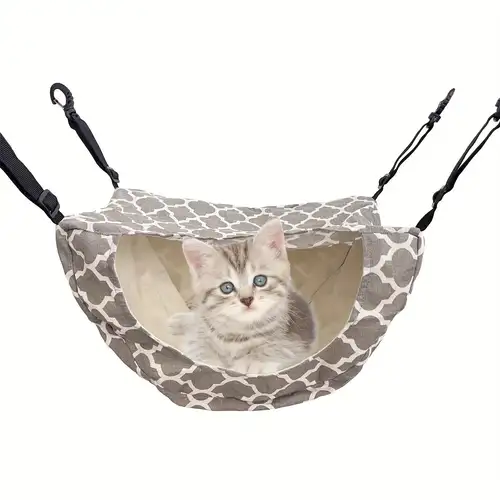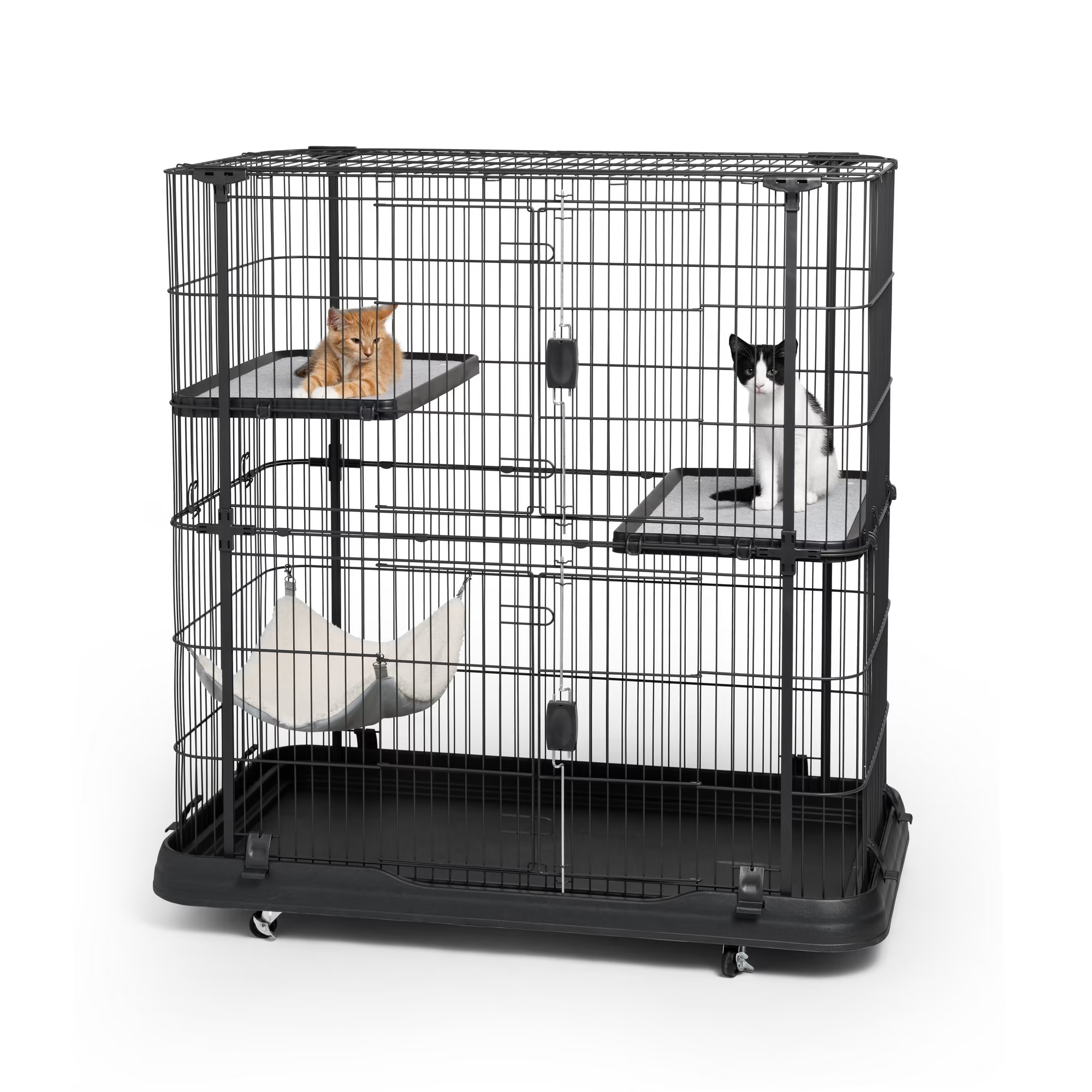Cats are notorious for their independence and agility. So, the idea of confining a feline friend to a cage can be unsettling for both the cat and the owner. However, cage rest, sometimes referred to as crate rest, can be a crucial part of a cat’s recovery after surgery, injury, or illness. This article will equip you with the knowledge and resources to ensure your cat has a comfortable and stress-free experience during cage rest.
In This Article
When is Cage Rest Necessary for Cats?
Veterinarians typically recommend cage rest for cats in two main scenarios:
- Post-surgical recovery: After undergoing surgery, especially orthopedic procedures or abdominal surgeries, cats require restricted activity to minimize strain on the incision site and promote proper healing.
- Medical conditions: Certain medical conditions, like fractures, sprains, or neurological disorders, can necessitate cage rest to prevent further injury or complications. In these cases, cage rest allows the body to focus its energy on healing rather than expending it on movement.
The duration of cage rest will vary depending on the severity of the surgery or illness. Your veterinarian will establish a specific timeframe tailored to your cat’s individual needs. It’s important to adhere to these guidelines for optimal healing. While cage rest might seem restrictive, it’s ultimately a temporary measure that promotes a safe and speedy recovery.
Creating a Comfortable Cage Environment
A crucial aspect of successful cage rest is creating a comfortable and stimulating environment for your cat. Here are some key considerations:
-
Choosing the right cage: Select a cage that’s large enough for your cat to stand up, turn around, and comfortably lie down. A general rule of thumb is that the cage should be at least three times the length of your cat from nose to tail. Consider a wire cage that provides good ventilation and allows for easy cleaning.
-
Bedding and comfort items: Line the cage floor with a comfortable, absorbent bed. Avoid thick bedding that could obstruct movement post-surgery. Soft towels, fleece blankets, or a cat bed are suitable options. Provide familiar toys and items with your cat’s scent to promote feelings of security.
-
Location, location, location: Place the cage in a quiet, well-lit area of your home. Avoid high-traffic areas or locations exposed to direct sunlight or drafts. If your cat is easily stressed, consider covering half the cage with a blanket to create a den-like atmosphere.
-
Litter box and food/water access: Ensure your cat has easy access to a clean litter box and fresh water within the cage. Position the food and water bowls in a way that’s comfortable for your cat to access while avoiding spills onto the bedding.
Keeping Your Cat Mentally Stimulated During Cage Rest
While physical activity is restricted, mental stimulation is vital for your cat’s well-being during cage rest. Here are some ways to keep your feline friend engaged:
-
Interactive toys: Provide puzzle toys or food dispensing toys that challenge your cat mentally and encourage problem-solving skills.
-
Playtime outside the cage: Supervised short bursts of playtime outside the cage can provide much-needed mental and physical stimulation. Engage your cat with interactive toys like feather wands or laser pointers, keeping sessions short and avoiding any strenuous activity.
-
Catnip: A sprinkle of catnip on a scratching post or toy can provide a burst of playful energy for your cat.
-
Visual enrichment: Place the cage near a window where your cat can observe outdoor activity or perch a scratching post within the cage that allows for window viewing. This can help alleviate boredom and provide environmental enrichment.
-
Talking and interaction: Even though physical interaction might be limited, don’t neglect talking to your cat in a soothing voice. Spend time near the cage, read aloud, or offer gentle petting when your cat is receptive.
Maintaining Hygiene and Minimizing Stress
Regular cleaning is essential during cage rest. Remove soiled litter promptly and replace the bedding as needed. Use a pet-safe disinfectant to clean the cage floor and food/water bowls daily.
Minimizing stress is paramount for your cat’s healing process. Here are some additional tips:
-
Minimize disruptions: Avoid introducing new pets or making significant changes to your cat’s routine during cage rest.
-
Gentle handling: When handling your cat for cleaning or playtime, be gentle and supportive, especially if your cat has undergone surgery.
-
Feliway diffusers: Consider using a Feliway diffuser, which releases synthetic feline pheromones that promote feelings of calmness and security in cats.
Remember, patience and understanding are key during cage rest. If your cat exhibits signs of excessive stress, vocalization, or attempts to escape the cage persistently, consult your veterinarian for guidance.

Consultation with a veterinarian for a proper timeline
Consulting your veterinarian is crucial for establishing a proper timeline for your cat’s cage rest. Here’s why:
- Individualized Needs: Every cat heals at its own pace. Factors like age, overall health, and the severity of the surgery or illness will influence the duration of cage rest. Your veterinarian will consider these factors to create a personalized timeline for your feline friend.
- Monitoring Progress: Regular check-ups with your veterinarian are essential during cage rest. These appointments allow the vet to monitor your cat’s healing progress, assess pain levels, and adjust the cage rest duration as needed. Early signs of complications can also be identified and addressed promptly.
- Post-operative Instructions: Following surgery, your veterinarian will provide detailed post-operative instructions that often include specific guidelines for cage rest. This timeframe is established based on the complexity of the surgery and your cat’s specific needs.
- Adapting the Plan: Unexpected situations might arise during recovery. For instance, if your cat exhibits signs of excessive stress or difficulty adjusting to cage confinement, your veterinarian can modify the plan. This could involve introducing shorter periods of supervised activity outside the cage or exploring alternative confinement methods.
Here’s how to get the most out of your consultation with the vet regarding cage rest:
- Gather Information: Before your appointment, note down any questions you have about cage rest, including the expected duration, activity restrictions, and proper cage setup.
- Detailed History: Provide your veterinarian with a detailed history of your cat’s condition, including the surgery or illness, any pre-existing medical issues, and your cat’s typical behavior.
- Observe and Report: Observe your cat’s behavior during cage rest and report any changes in appetite, litter box habits, or activity level to your veterinarian.
- Open Communication: Maintain open communication with your veterinarian throughout the cage rest period. Don’t hesitate to reach out if you have any concerns or if your cat seems uncomfortable.
By working collaboratively with your veterinarian, you can ensure your cat receives the optimal level of care and has a smooth recovery from surgery or illness.

Conclusion: Working Together for a Speedy Recovery
Cage rest, while necessary for healing, can be a challenging experience for both cats and their owners. By following the tips outlined above, you can create a comfortable and enriching environment for your cat during recovery. Remember to prioritize your veterinarian’s recommendations and maintain open communication throughout the process. With patience, understanding, and a commitment to providing a positive experience, you can help your cat navigate cage rest and emerge happy and healthy.



